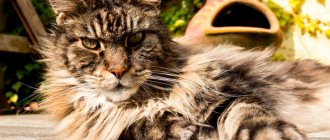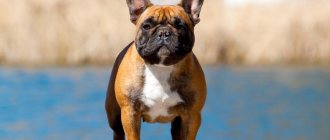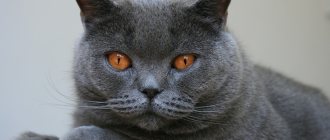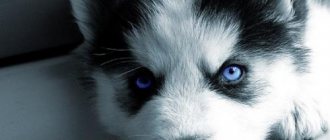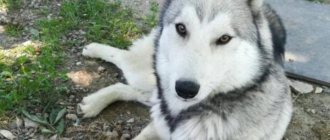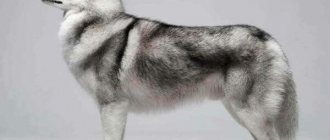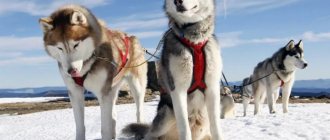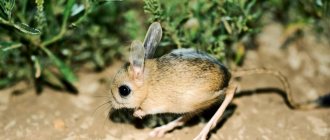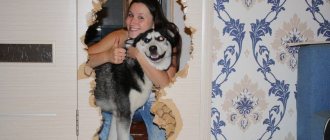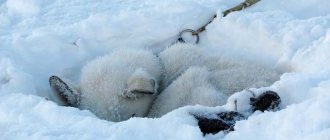The homeland of Siberian huskies is the northeastern part of Siberia.
In these parts there are quite difficult conditions for survival and people were forced to look for not just a companion, but a reliable friend and helper.
This is how the husky appeared. It is believed that the ancestors of this breed were wolves and northern wild dogs.
The dog's height is 50-60 cm, weight is 18-28 kg, life expectancy is 12-15 years.
What does an adult husky look like?
The Siberian Husky is one of the most beautiful and unpretentious dog breeds. The dog is distinguished by its ease of gait, speed and unusual almond-shaped eyes.
As for the body, it can be called moderately compact and quite strong. The dog has a medium-sized head, a strong loin and a slightly sloping croup. Adult huskies have powerful and strong paws, as well as developed muscles, which allows the dog to move quickly and gracefully.
In general, the dog makes a rather harmonious impression, due to the fact that the limbs, head, muzzle and neck have a proportionally correct relationship. The tail of Siberians is fluffy, slightly similar to a fox’s, in an excited state it is raised up, in a calm state it is lowered. The ears are erect, high-set, triangular in shape.
It’s worth mentioning separately about the pet’s eyes; they can be blue or brown in color; heterochromic eyes (different colors) are also allowed by the breed standard. Moreover, their shape in this breed is almond-shaped, and their location is slightly slanting.
The coat of such pets is of medium length, very thick, soft with a dense undercoat. The color palette can vary from snow-white to black.
NOTE!
The husky's calling card is a special mask on its face, which has a unique pattern that is unusual for representatives of other breeds.
History of the origin of the breed
A pair of huskies with a typical
Husky color is a specialized breed of dog that was bred by the Chukchi in the northeastern region of Siberia. American dog handlers first registered the Husky in the 1930s as a sled dog bred from the aboriginal dogs of the Russian Far East. This means Kamchatka, Kalyma, Anadyr with local settled tribes and coastal Chukchi. Today, the oldest breed of dog is used as a sled dog, companion dog, and show dog.
Since the Neolithic period, in the Far East of Russia there were aboriginal sedentary peoples, whose main activity was fishing and hunting sea and land animals. Their descendants include the Nivki, Yukaghir-Chuvans, Kereks, and Asian Eskimos. It is thanks to them that the tradition of breeding sled dogs has been preserved.
For reference! They were able to feed the dogs enough food in the form of dried fish. In their opinion, a good team required a minimum of 9 dogs.
Husky sled dogs
Sled dog breeding began to develop more actively in the 17th–18th centuries due to the Russians’ need to develop the area in order to find “soft gold.” They needed transport to deliver mail, goods, and travel for officials.
The demand for sled dogs increased sharply during the first outbreak of the Gold Rush in Alaska. For the first time, sled dogs were brought from the Russian Far East to Alaska in 1908. Due to their excellent racing qualities, the dogs were purposefully imported to the United States for 20 years.
The dogs actively took part in races and were bred. Then the policy of merging the breeds into one began. Huskies were considered unpromising due to their replacement by vehicles and motorized sleds.
Attention! In 1934, America officially recognized the “Siberian Husky” and set a standard.
Breed standard
According to international breed standards, purebred huskies must meet the following requirements:
- The dog's head should be proportional to the body, the muzzle should be of medium width, and the lips should be thin (not loose).
- The eyes of this breed are almond-shaped, set slightly slanted and moderately wide. According to the standard, heterochropromia of the eyes (different colors of the irises) is allowed.
- The pet's ears are medium-sized, triangular and high-set.
- The chest is powerful, but not too wide.
- The neck is curved and raised.
- Paws (front and rear) are straight, parallel, slightly spaced apart.
- The tail is bushy, set just below the top line of the back, in an excited state it is curled up in the shape of a sickle, and in a resting state it is dropped down.
- This pet's coat is short, but very thick, and the undercoat is dense and soft.
Character traits
Siberian Huskies are considered quite intelligent and sociable animals, they are especially attached to children, they are excellent nannies and friends of children.
Some even believe that such a dog does not need special training; simple interest is enough for him.
At the same time, huskies are so friendly that they calmly accept even completely strangers and animals. But at the same time, they can be wayward and stubborn; they simply need a strong leader.
In addition, the dog requires daily physical activity, as its activity is simply off the charts.
IMPORTANT!
The Siberian Husky is a breed that will never become a watchman or guard, due to its natural friendliness. At the same time, violent induction of aggression can lead to mental disorders.
Breeds that are often confused with Husky
The breeds most often called husky varieties are:
- Sakhalin Laika.
- Klee-kai.
- Malamute et al.
In fact, these are amateur breeds with their own history and standards.
Sakhalin Laikas
Sakhalin huskies are a very rare and ancient breed of dog. Their homeland is Sakhalin Island. These are dogs with a very powerful and large body, an elongated body and a strong skeletal system.
As for the differences between the Sakhalin husky and the husky, they are very significant. Firstly, this is the exterior. Secondly, huskies are more suitable for hunting, while huskies are more suitable for sledding. In addition, Sakhalin huskies can bark from time to time like an ordinary dog, but huskies practically do not do this to express emotions; they howl like wolves.
Klee Kai
Other names for this breed are mini-husky or toy husky, its homeland is the USA, the time of appearance of the breed is the 1970s.
Klee Kai are small, playful and very beautiful dogs, similar in appearance to huskies, but smaller in size. The height of such a pet is 33-35 cm, weight -7-8 kg, but there are also smaller varieties. This dog is very friendly, so it is most often kept in an apartment as a pet or a companion for children.
Alaskan Malamute
The Alaskan Malamute's closest relatives are the German Shepherd, Northern Husky and Border Collie. Outwardly, such a dog is a cross between a Siberian husky and a husky.
The coat of such a dog is short, but thick and dense; the hair is almond-shaped and has a blue or brown tint. Life expectancy is 12 -15 years.
By nature, Malamutes are loyal, gentle and affectionate; they are especially kind to children and play with them with pleasure. In addition, dogs are very active, mobile and require long walks and active games.
Abstract description of the Husky breed
Molting occurs twice a year. Mostly moderate, but during the shedding season a large amount of hair falls out, so you will have to brush your dog daily.
Huskies do quite well in apartments, provided they have the opportunity to exercise. The ideal place to keep it is a private country house.
If the animal does not find an outlet for its violent energy, it will begin to chew the slippers. In the courtyard of a country house, huskies will dig holes under the fence and loosen the ground.
Husky dogs practically do not bark, even when someone unfamiliar approaches their home territory. Therefore, this breed is not used as a guard dog.Due to their stubborn nature, these dogs are not suitable for novice dog owners. They certainly need a leader in the person of a strict master.
Since huskies are curious, they often get injured and get lost when leaving their home.
These good-natured animals are ideal pets for families with children.
When buying a husky puppy, you should find out about its diet. They generally don't need a lot of high calorie food.During walks, it is recommended to let the animal off a leash to give it the opportunity to chase small representatives of the fauna.
Photos and descriptions of colors
This breed has a wide variety of colors, with some colors considered basic, while others are rare. Some colors are found only in working or riding lines of the breed and are not found in show representatives.
The most common types of colors:
- Black . In its pure form it is very rare and can be interspersed with small light areas of fur on the paws, tip of the tail and muzzle. However, for a pet to be considered black, at least 75% of its body must be black.
- Absolutely white is also considered a very rare color. It is characterized by a completely white coat and the same undercoat. The color of the nose can be black, brown or flesh-colored.
- Black and white . In this case, the percentage of colors will be 50/50. From above, the dog is torn by a solid black stripe, covering the back, the top of the head and part of the tail. There is a white stripe below, while the paws are always white and have reddish areas on the folds.
- Silver color allows the presence of only gray colors, while all warm shades are absent here. The color of the undercoat can vary from white to silver.
- Grey . With this color, the coat color will be black, and the undercoat color will be silver with beige shades.
- Copper or chocolate color . It is characterized by rich copper and dark red colors of the coat and undercoat, and the presence of white and cream colors is also acceptable.
Smooth-haired and long-haired
If we talk about the smooth-haired husky, then its coat can be called double, well-haired, thick, but not long. It does not hide the dog's silhouette, has a soft, dense undercoat and straight guard hair.
During the molting period, the undercoat may be absent and this is the norm. A long, coarse or shaggy coat is a fault and will result in a lower score in the show.
As for long-haired huskies, their hair is slightly longer than that of smooth-haired representatives of the breed. At the same time, it is not inferior in softness and thickness. Along the back line of such pets there is a stripe of longer hair than on other parts of the body. As for the colors, they fully correspond to this breed, as does the physique.
NOTE!
According to international standards, heavily fluffy huskies are considered not purebred and are not allowed for exhibitions.
How it develops week by week in the first month
The first month of a puppy’s life is associated with their constant changes and the most intensive development.
During the first 10 days after birth, babies go through a phase of primary adaptation to the conditions of the world around them, especially to temperature and smells.
At this time, puppies grow very rapidly, almost doubling their body weight in the first week of life . They become more active and the breeder can already assess which of the babies in the litter is stronger and which is weaker.
Stronger puppies are the first to crawl to the nipples, pushing away those who are a little weaker; they gain weight faster and open their eyes earlier.
At about 11-16 days, puppies' eyes open, and at 17-18, their auditory canals open . Little huskies continue to adapt to their environment, they can already see objects and hear sounds.
By 16-18 days, milk teeth begin to erupt, first the back ones, later the front ones.
The nose of the nose acquires uniform pigmentation by the 4th week of life of puppies; during the same period, the palate of babies darkens, and black spots appear on the lips.
At the age of 3 weeks, Husky puppies walk well, and at 1 month they run confidently.
Do these dogs need to be groomed?
According to experienced dog breeders, it is not advisable to cut your Husky's hair, with the exception of light hygienic trimming, in which the trimmed dog simply takes on a more well-groomed appearance - regrown hairs are removed between the toes, around the anus and genitals, as well as in the ear area. This treatment is done for hygienic purposes and should not affect the appearance of the dog.
Another reason why it is not recommended to cut huskies is a violation of heat exchange, because thick hair warms the dog in winter, and saves it from the heat in summer.
A properly trimmed Husky looks neat without altering its natural contours.
History of the breed and photographs of dogs
Scientists believe that the need to breed sled dogs among the peoples inhabiting the territory of modern Chukotka arose at a time when they decided to expand their hunting territories.
In order to lead a semi-nomadic lifestyle, a strong but agile sled dog was needed that could travel long distances in winter, even during severe frosts and snowfalls, carrying not too heavy luggage on a sleigh and at the same time expending a minimal amount of energy.
The Chukotka sled dog, which became the ancestor of modern Siberian huskies, fully met these requirements. Hardy, unpretentious to living and feeding conditions, it not only allowed the indigenous peoples of the North to settle over vast territories, but also played a huge role in the development of the Arctic and Antarctic.
Probably, huskies with blue eyes appeared several centuries ago, however, due to the fact that in those days people did not need show dogs, but working dogs, they did not pay attention to the exterior features of their pets.
If animals with blue eyes were in no way inferior to brown-eyed ones in terms of their working qualities, then they participated in breeding in the same way. Likewise, if dogs with dark eyes did not live up to their owners' expectations, they were culled.
At the same time, natural selection also played a role, when only the strongest sled dogs survived and gave birth to offspring.
NOTE!
People from local tribes involved in breeding them rarely interfered with the breeding process of these dogs, but at the same time they made sure that interbreeding did not occur.
Chukchi sled dogs were brought to Alaska in 1908, where they were widely used during the Gold Rush. Later, representatives of this breed became famous for delivering the vaccine to the city of Nome in Alaska, which was affected by a diphtheria epidemic. Huskies also participated in sports races, showing excellent race results.
The breed received official recognition in 1934 and was called the “Siberian Husky”. And from this time on, the use of huskies as popular show dogs began.
Considering that blue-eyed dogs were especially popular at exhibitions and looked extremely unusual and, in the opinion of many people, cute, both professional breeders and amateurs began to actively breed them.
Are boys different from girls?
Sexual dimorphism in this breed is quite pronounced - a male, as a rule, is more powerful, stronger and stronger than a girl. In addition, it always has a more elegant color and looks more impressive.
But it would be wrong to say that girls of this breed look pale and homely. At the same time, knots are always smaller in size and have a slightly lighter frame. However, they are not fragile and delicate, since such individuals were cut off by centuries-old selection in the north.
As for exhibitions, males usually make a stronger impression due to their representativeness and brightness of color.
Development from 1 to 12 months
| Age | Male height at withers, cm | Male back length, cm | Height of the bitch at the withers, cm | Bitch's back length, cm | Weight, kg | Description |
| 1 month | – | – | – | – | 2,7 | Babies are actively growing, already 2 weeks after birth their body weight increases by about 3 times |
| 2 months | 32 | – | 30 | – | 5,9 | The puppies are already well built, confidently move independently, their ears are starting to stand up |
| 3 months | 42 | – | 40 | – | 10,5 | Babies need to be fed 5 times a day, the accelerated growth rate continues |
| 4 months | 48,4 | 50 | 47 | 50 | 14,3 | Puppies begin to take on adult characteristics |
| 5 months | 53 | 54 | 51 | 52,5 | 19,5 | Husky lines and traits continue to develop |
| 6 months | 55 | 57 | 53 | 54 | 21,5 | The dog is already big and tall, but it is still a puppy, continuing to form |
| 7 months | 57 | 58 | 55 | 55 | 24,3 | The dogs are practically no different from adult representatives of the breed. |
| 8 months | 58 | 59,5 | 56 | 56,5 | 25,5 | Puberty, growth rate slows down |
| 9 months | 59 | 60 | 57 | 57,5 | 26,5 | Height at the withers is the same as that of an adult |
| 1 year | 60 | 62 | 58 | 59 | 28 | An adult dog, the period of growth and weight gain has stopped, but formation continues |
What do the puppies look like?
In the 1st month of life, husky puppies go through 2 most important periods of their lives.
The first 2 weeks are considered the neonatal period. At this time, babies are almost completely helpless and are dense lumps, unable to see, hear, empty themselves and warm themselves. The mother performs all these functions for them.
Starting from the 3rd week, puppies enter a transition period. At this time, their eyes are already open, hearing and interest in the world around them appear.
By the end of the first month, the baby already has milk teeth and begins to taste solid food. At the same time, the puppy continues to feed on mother's milk.
From the 2nd to the 3rd month of life, the dog actively gets acquainted with the world around him, he is curious, sociable and affectionate. This time is also considered a period of early training.
It is during this period that boys experience the descent of the testes into the scrotum. If this does not happen or only one testicle has descended, then you should consult a veterinarian. Often the reason for non-descent of the testes can be stress or emotional overload, since puppies are especially vulnerable at this age.
At the 3rd month of life, the puppy’s weight increases approximately 3 times, and the height at the withers increases by 2 times. At the same time, active growth of tubular bones, chest and skeleton continues. At the same age, puppies begin to establish a hierarchy and the owner’s task is to show the baby who is boss in the family. Also at this time, baby teeth begin to change to permanent ones.
At the 4th month of life, the baby’s growth and development stabilizes and gradually slows down; the puppy enters a period of independence. He also experiences the appearance of his first sexual instincts, which often manifests itself in jumping on fellow tribesmen or on the owner’s leg.
5-6 months – period of independence. The puppy can become very willful, which results in ignoring commands or defiant behavior. At the same time, the eruption of permanent teeth is completed, so the dog has a constant need to chew something. This age is the best period to attend obedience courses.
The age of 6-8 months is another growth spurt, as well as a period of strong fears. During this time, the dog may behave a little strangely, for example, it may be afraid to approach something or refuse to do something that it did before. Outwardly, at this age, the puppy becomes similar to an adult dog.
From 8 to 12 months, a husky is considered a sexually mature young dog. By this moment, all senses have already been formed and the puppy’s perception of the world around him is comparable to the perception of an adult dog.
Development by months
The most active development of any dog is in the first months of life. Then it slows down somewhat, ending completely by 10-12 months of life.
Puppy at birth
A newborn husky puppy weighs 350-450 g - the parameters depend on the gender of the kitten, the characteristics of its parents, and the number of babies in the litter. Premature puppies are always smaller and weaker than dogs born at full term.
In the first days of life, babies are completely helpless - they cannot see, they cannot hear. They only need warmth, sleep, and mother's milk. During this period of development, the owner and breeder must provide comfortable conditions - temperature, noise conditions, optimal lighting.
Photos and videos of newborn huskies:
2 weeks
On the 10-14th day of life, the cubs' eyes appear and their ears open. But they still don’t see or hear very well. However, they strive to explore the world - crawl, run, meet other residents of the house.
The puppies still have enough mother's milk, but the owner is already introducing liquid and then soft complementary foods. Monitors allergic reactions and the response of the gastrointestinal tract of babies to new food. With proper care, puppies already weigh 1.7-2 kg.
In the photo and video - a husky at 2 weeks:
1 month
Little huskies turn into funny, plump bear cubs: weight reaches 3.8-4 kg, height at withers - 22-23 cm. Puppies become more independent, switch to soft and hard foods. They play with each other, “communicate” with their mother. She teaches them to be dogs: contact with their relatives, the meaning of barking, tail position, various facial expressions and poses.
At this time, human upbringing begins - the puppy is taught a name and prohibitions are established for it. It is important not to skip this stage, otherwise a wayward dog may grow stubborn and almost uncontrollable.
Photos, videos of one-month-old huskies:
2 months
The puppy almost doubles in size: up to 7-8 kg. His “figure” begins to slightly resemble that of an adult husky. The kitten grows to 32-33 cm at the withers, its ears stand up.
Puppies at this time are very energetic, eat a lot, with an appetite - the frequency of their feedings reaches 6 times a day. Young animals play with each other in attack, defense, and pursuit. They already trust the person and see him as an older friend. At this age, dogs already understand what a bite is and learn to regulate its strength.
Husky puppy 2 months:
3 months
A three-month-old kitten is given 5 meals a day. This is either a natural, balanced diet made from fresh, high-quality products, or premium food for puppies. Cubs of this age are finding a new home: it is important for the owner not only to surround the baby with care, but also to firmly set “dos” and “nots.”
The dog is noticeably gaining weight. It grows up to 38-42 cm. He runs well, “tells” his mood with his tail, and already copies an adult dog in behavior.
Photos and videos of husky at 3 months:
4 months
Depending on the gender and individual characteristics, the puppy weighs 11-14 kg. From a “child” it turns into a teenager: the height at the withers is 44-46 cm. The Husky noticeably elongates in length and becomes taller.
From this age, the dog can be involved in active training and education can continue. Teenage huskies are already showing their stubbornness and trying to dominate people. It is important for the owner to nip the pet’s desire to become the “leader of the pack” in the bud. Smart huskies perfectly understand emotions, tone of voice, and rising intonation. Physical punishment is unacceptable - the dog grows up nervous, intimidated, and aggressive.
Photos, videos of four-month-old huskies:
5 months
The development of a husky is no longer as active as in the first months of life: the weight of a five-month-old puppy reaches 13-15 kg, the height at the withers is 48-50 cm. The dog’s body shape becomes narrower and elongated.
Training and education continue. Active walks, running, and exercise on the playground take at least 2 hours a day. This is necessary for the development of the animal. Full physical activity is the key to husky obedience. If the dog has not had enough exercise, he becomes capricious, nervous, and may begin to damage the owner’s property. Sometimes energetic pets “cry” from lack of walks and fall into apathy.
In the photo and video - a husky at 5 months:
6 months
Six-month-old huskies weigh 16-18 kg. They increase their height quite well - up to 50-55 cm. The frequency of meals is reduced: the amount of food should correspond to the activity of the animal. The dog’s development slows down somewhat, so the need for “enhanced” feeding gradually disappears.
Six-month-old husky:
7-12 months
Next, the development of the young husky goes through the following stages:
- 7 months. The “teenager” begins to resemble an adult dog in appearance and becomes 2-3 kg heavier. Its height is about 52-56 cm.
- 8 months. Girls are already in their first heat, but mating is contraindicated - the dog’s body is not yet ready for motherhood. The weight of the Siberian Husky reaches 22-24 kg with a height at the withers of 54-57 cm.
- 9 months. The dog's height is 54-58 cm, almost like an adult dog. Weight ranges from 24-26 kg.
- 10-12 months. The dog is growing slightly and gaining some weight - up to 28 kg. At this age, the dog’s development slows down - it can boast the parameters of an adult husky.
The animal stops growing, but continues to “mature”: it becomes larger, more muscular. His “figure” is made harmonious: boys look more powerful, and girls look graceful. With proper care and a balanced diet, the weight of a male dog can reach 40 kg.
Photos and videos of husky at 7 months:
Photos and videos of a Siberian Husky at 9 months:
In the photo and video - Siberian Huskies at 12 months:
Adult animal
Adult huskies are distinguished by their strong, wide bones and powerful muscular body. These are “seasoned”, hardy animals, but very graceful, not distinguished by the coarseness of their forms. Average parameters of an adult animal:
- Weight: 15-30 kg.
- Height at withers: 50-62 cm.
- Body length: 50-60 cm.
Popular colors:
- snow-white;
- grey;
- black;
- golden;
- copper;
- ginger.
The color of the nose and eyes depends on the suit. The shade of the iris can be blue, amber, black. The eyes themselves are somewhat slanted, friendly and mischievous.
Another feature of the breed is its closely spaced triangular ears, standing strictly vertically upward. Huskies always keep their heads held high. In combination with a beautifully arched neck, this forms a noble, graceful posture.
The husky's tail is similar to a fox's, evenly pubescent. If the dog is tense, it bends beautifully into a “sickle”. The wool is soft, loose, fluffy. The hairline is double: awn and undercoat.
Height and weight chart
Average indicators for puppies by month are in the table.
| Age (months) | Height (cm) at withers | Weight, kg) |
| 1 | 20-23 | 3-4 |
| 2 | 23-30 | 4-6 |
| 3 | 30-40 | 6-9 |
| 4 | 40-45 | 10-13 |
| 5 | 45-50 | 13-17 |
| 6 | 50-52 | 17-20 |
| 7 | 50-55 | 20-23 |
| 8-9 | 50-57 | 23-25 |
| 10-12 | 50-60 | 25-30 |
Minor deviations from standard indicators are not a cause for concern. These are individual characteristics of a puppy’s development, determined by genetics, health, and feeding.
Development schedule for puppies of the same litter:
How to choose your future pet?
Before deciding on a puppy, you need to do the following:
- Inspect several kennels, compare prices and conditions for keeping dogs.
- Examine the entire litter at the age of 1-1.5 months and compare the puppies. It is at this age that the dog’s character and temperament, as well as its behavioral skills, manifest themselves.
- Pay attention to the puppy's health condition. A healthy baby should be moderately well-fed, active, and well-groomed. In addition, he must have a good appetite and a healthy interest in the outside world.
- You must definitely ask the owner of the kennel to show the documents of the parents, as well as the puppies themselves.
You can pick up your baby at the age of 1.5-2 months; it is during this period that puppies are already quite independent and easily adapt to new conditions.
IMPORTANT!
Despite the fact that this breed is suitable for keeping in an apartment, it is not recommended to leave the dog alone at home for a long time. Otherwise, the pet may get bored and start acting up. In addition, loneliness makes the husky too independent and disobedient.
Blue eyes - standard or defective?
Blue eyes in this breed are recognized as a standard and cannot be considered a breeding defect.
According to the legends of one of the northern peoples, who have been breeding sled dogs since ancient times, the blue tint of the eyes appeared among the ancestors of the husky because one of these dogs peered into the icy expanses of the ocean for so long, sitting on the shore, that the cold that seemed so beautiful and bewitching to him , completely captured his heart and colored his eyes an icy blue-blue hue.
So says the legend, but what do scientists think about this?
According to genetic studies, the blue tint of the eyes in huskies turned out to be associated with a mutation that led to duplication of the ALX4 gene, which determines the process of eye development in mammals.
NOTE!
The saturation of the shade depends on the density of the collagen fibers that form the outer layer of the iris vessels.
If the collagen layer is less dense, then the husky's eye color will be darker, bluish. In dogs with a denser collagen layer on the iris, the eye color will be lighter, even pale blue or even grayish.
In the extremely rare merle-colored huskies, there may be another reason for blue eyes - the influence of the merle gene. It can also cause a dog to have one eye blue and the other brown. In this case, the marbling gene affects only one eye, changing its color from brownish, amber or olive to bluish or blue.
Finally, there is another reason for the appearance of blue eyes in a husky puppy - albinism. However, you need to understand that an albino husky is not the same as just white dogs of the same breed, whose eyelids and lips will be black.
An animal with the albinism gene will have no melanin completely, causing its skin to be completely devoid of pigmentation, which is considered unacceptable according to the breed standard. The eyes of an albino husky will be a very pale, milky bluish hue, very different from the rich and rather bright icy blue of the usual iris color characteristic of representatives of this breed.
